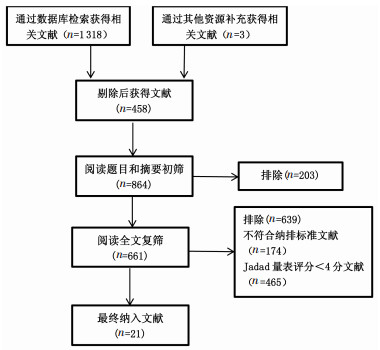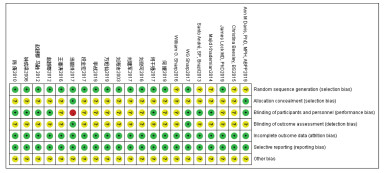
文章信息
- 仇雅朋, 李晓璇, 蔡秋晗, 胡思源
- QIU Yapeng, LI Xiaoxuan, CAI Qiuhan, HU Siyuan
- 小儿厌食症临床试验设计与评价技术要点的文献研究
- A literature study on the design and evaluation techniques of clinical trials for infantile anorexia
- 天津中医药, 2020, 37(5): 559-564
- Tianjin Journal of Traditional Chinese Medicine, 2020, 37(5): 559-564
- http://dx.doi.org/10.11656/j.issn.1672-1519.2020.05.15
-
文章历史
- 收稿日期: 2020-03-10
2. 天津市滨海新区妇女儿童保健和计划生育服务中心, 天津 300459
厌食症是国内中、西医儿科共用的病名。《诸福棠实用儿科学》认为,本病首先是一种摄食行为异常的表现,临床可伴或不伴胃肠道功能的异常[1]。近年来,国外对于本病的分类诊断认识逐步深化,如Chatoor的“婴儿和儿童早期喂养障碍”中[2]的“婴幼儿厌食症”,《精神障碍诊断与统计手册(第五版)》(DSM-5)[3]的“回避性/限制性摄食障碍”,《疾病和有关健康问题的国际统计分类第十次修订本》(ICD-10)[4]的“婴儿和儿童期喂养障碍”,以及以色列Edith Wolfson医疗中心的“婴幼儿喂养障碍”[5]等,均以缺乏进食兴趣/甚至拒食、食物摄入不足为主要临床特征,近似或涵盖本病。
近年来,有关小儿厌食症及其相关疾病的临床研究文献虽逐渐增多,但试验设计差异较大,文献质量大多不高,影响了试验结果评估及二次文献研究。文章通过文献检索,选择2000—2019年国内外、中英文的高质量随机对照临床试验(RCT)文献,分析、归纳、提炼小儿厌食症临床试验设计与评价的技术要点,期望能为本病的临床试验设计提供借鉴与参考。
1 资料与方法 1.1 文献的纳入标准与排除标准 1.1.1 纳入标准1)2000—2019年的中、英文文献。2)研究类型为临床RCT。3)具有/符合小儿厌食症及其相关疾病(喂养障碍、回避性/限制性摄食障碍)的诊断标准。4)干预措施为中医药、化学药或行为治疗。5)改良Jadad量表评分≥4分。
1.1.2 排除标准1)半随机对照试验。2)会议文献、综述、文摘及无法获取全文信息的文献。3)神经性厌食。4)重复发表的文献。5)内容有明显错误的文献。
1.2 文献的检索方法及策略检索的数据库,包括中国知网数据库(CNKI)、中国生物医学文献数据库(CBM)、维普中文科技期刊数据库(VIP)及万方数据库(WF)、中国临床试验注册中心、Pubmed、Embase、Cochrane Library及Clinicaltrials。检索年限为2000—2019年。中文检索词包括小儿、儿童、幼儿、学龄前;厌食、厌食症;喂养障碍;摄食障碍;临床试验、临床疗效、随机。英文检索词包括infantile、chlid*、teen*、pedia*;Anorexia;feeding disorders;avoidant/restrictive food intake disorder;intake disorder;RCT、random。根据每个数据库的具体情况选择主题词、关键词、摘要、全文等多种检索方式以保证检索的系统性。
1.3 文献筛选及资料提取 1.3.1 文献筛选参考Cochrane协作网系统评价员手册制定研究入选方法:1)将不同数据库的检索结果分别导入文献管理软件NoteExpress中。2)对文献进行查重。3)对查重后的文献逐篇阅读题目与摘要,剔除明显不相关的文献。4)获取相关文献的全文。5)逐篇阅读全文剔除不符合纳入标准的文献。6)对阅读全文剩余的文献运用改良Jadad量表评分,剔除评分≤3分的文献。
1.3.2 资料提取应用Excel制作信息提取表,由两位研究者独立提取纳入文献的主要信息。对于存在分歧的资料,两名研究者可讨论协商解决,或咨询第三方评价者帮助解决。主要提取内容包括:题目、作者、试验设计(随机、对照、盲法、样本量估算、检验类型、多中心等)、诊断标准、纳入标准、排除标准、干预措施、合并治疗与用药、疗程、有效性指标及评价方法、安全性指标及评价方法、导入期及随访等。
1.3.3 文献质量评价参考Cochrane协作网系统评价员手册RCT的偏倚风险评估工具,对纳入研究的文献进行严格的偏倚风险评估。评价偏倚风险的具体内容包括6个方面7个条目:1)选择性偏倚(随机序列的生成、分配方法隐匿)。2)对受试者和研究人员实施盲法(实施偏倚)。3)结局评价者盲法(测量性偏倚)。4)结果数据不完整(随访偏倚)。5)选择性报告(报告偏倚)。6)其他潜在来源的偏倚。
2 结果 2.1 检索结果共检索文献1 321篇,排除重复或重复发表的文献458篇,阅读题目、摘要排除文献203篇,阅读全文排除文献174篇,以改良Jadad量表评分<4分排除文献465篇,最终共纳入14篇中文文献和7篇英文文献[6-26]。文献筛选流程,见图 1。

|
| 图 1 文献筛选流程 Fig. 1 Literature screening process |
21项研究中,共纳入2 708例受试者,试验组1 356例,对照组1 132例,样本量最大451例,最小16例(其中3项研究未明确试验组与对照组例数[21, 25-26])。
2.2 纳入研究的质量评价采用Cochrane协作网提供的偏倚风险评估工具,对纳入研究的21篇文献进行偏倚风险分析,其总体偏倚风险较低,纳入文献质量较高。见图 2。

|
| 图 2 纳入研究的偏倚风险总结 Fig. 2 Summary of bias risk of included studies |
纳入的全部21项研究中,国内研究14项(66.67%),国外研究7项(33.33%)。14项国内研究中,均以改善食欲不振症状或和增加食量为主要目的,同时探讨改善生长和营养状况3项(21.43%);7项国外研究中,以改善摄食行为、食欲不振症状、摄食量、小儿生长和营养状况为主要目的,分别为4项(57.14%)、1项(14.29%)、1项(14.29%)、1项(14.29%)。
3.2 研究总体设计主要包括随机、对照、盲法、样本量估算、检验类型等内容。21项研究中,选择阳性药、安慰剂、行为治疗和空白对照,分别为14项(66.67%)、4项(19.05%)、1项(4.76%)、2项(9.52%);采用双盲法设计10项(47.62%),未设计盲法11项(52.38%);多中心研究9项(42.86%),单中心研究12项(57.14%);有样本量进行估算研究1项(4.76%);选择差异性检验设计19项(90.48%),非劣效检验、优效性检验设计各1项(4.76%)。
3.3 诊断标准及辨证标准21项研究的西医诊断标准中,具有明确来源者16项(76.19%),符合者5项(23.81%)。有明确来源的16项研究,包括各版《诸福棠实用儿科学》[1, 27-28]“厌食症”9项(56.25%),DSM-5[3]“回避性/限制性摄食障碍” 3项(18.75%),《中药新药临床研究指导原则(试行)》[29]2项(12.5%),以色列Edith Wolfson医疗中心“婴幼儿喂养障碍”[5]、Chatoor“婴幼儿厌食症”各1项(6.25%)[2]。
14项国内中医药研究中,有明确的中医诊断标准5项(35.71%),其中,《中医病证诊断疗效标准》[30]4项(80%),参考《中药新药临床研究指导原则》[29] 1项(20%)。有明确的中医辨证标准的研究11项(78.57%),其中,各版《中医儿科学》[31-32]7项(63.64%),《中医儿科常见病诊疗指南》[33]《中药新药临床研究指导原则(试行)》[29]各2项(18.18%),《中医病证诊断疗效标准》[30]1项(9.09%)。
3.4 受试者的选择与退出 3.4.1 纳入标准21项研究均设计了纳入标准。1)全部研究均符合厌食症及其相关疾病(喂养障碍、回避性/限制性摄食障碍)诊断标准。2)限定年龄范围19项(90.48%),下限为9个月~5岁,上限为5.5~14岁。3)进一步限定病程10项(47.62%),其中,≥1个月和≥2个月各4项(40%),≥3个月2项(20%)。4)有诊前治疗规定7项(33.33%),其中,近期未服用药物或未接受其他治疗者6项,近期未使用任何补充剂1项(14.29%)。5)明确规定签署知情同意书者9项(42.86%)。
3.4.2 排除标准21项研究中,设计了排除标准18项(85.71%)。1)与病种有关的排除标准12项(57.14%),包括消化系统疾病(如急慢性胃肠炎、消化性溃疡、肝炎)、精神性疾病(如神经性厌食)、呼吸道感染、肿瘤等。2)与干预措施相关排除标准8项(38.1%),包括过敏体质患儿及对试验用药或其成分过敏者。3)设计了通用排除标准14项(66.66%),包括合并其他系统严重疾病(如心肌炎、肾病综合征、胆囊炎),中、重度营养不良,近期服用过药物或接受过其他治疗,以及实验室指标异常者。
3.4.3 退出(脱落)标准21项研究中,其中设计退出(脱落)标准7项(33.33%),但15项(71.43%)有退出/脱落病例的表达。1)研究者决定退出7项(100%),包括失访或者资料不全,对试验药物过敏或出现不良事件,试验过程中罹患其他疾病,依从性差,各种原因的中途破盲病例,病例入选后违反纳排标准等。2)受试儿童自行退出7项(100%),包括不再接受用药及检测而失访者,不愿意或不可能继续进行临床试验者。
3.5 干预措施纳入的21项研究中,干预措施为中医药者11项(52.38%)、化学药4项(19.05%)、行为治疗3项(14.28%)、中药化药联合应用2项(9.52%)、行为治疗联合化药1项(4.76%)。中医药干预的11项中,中成药8项(72.73%),推拿、针灸、中药敷贴各1项(9.09%)。疗程4周8项(38.10%),2周6项(28.57%),1周、8周各2项(9.52%),10 d、3周、6个月各1项(4.76%)。有基础治疗设计3项(14.29%),均要求改变不良饮食习惯及制定合理的喂养计划;有合并用药设计1项(4.76%)。
3.6 导入期与随访21项研究中,均未设计导入期;有随访设计了1项(4.6%),随访时间为6个月,目的为观察小儿厌食的复发情况。
3.7 有效性评价 3.7.1 有效性指标纳入的21项研究均设计了2~4项有效性指标。14项国内研究中,以食欲食量改善综合评价(以厌食疾病疗效为主要指标)为主8项(57.14%);以中医症状整体评价(以中医症状/证候疗效为主要指标)为主6项(42.86%);其中含有体质量、身高指标评价3项(21.43%)。7项国外研究中,以喂养/摄食行为评价(以量表评分为主要指标)为主要指标4项(57.14%);以食欲不振改善、管饲喂养与口服卡路里的比例、体质量为主要指标各1项(14.29%),其中以营养状况改善为次要指标2项(28.57%),如身高、体质量及其Z评分,以及体重指数(BMI)、皮肤皱褶厚度等。
3.7.2 评价标准1)食欲食量改善综合评价标准,主要参考《中药新药临床研究指导原则(试行)》[29]制定。采用尼莫地平法,将疗效分为痊愈、显效、有效、无效4级。2)中医症状/证候整体改善评价标准,主要参考《中药新药临床研究指导原则》及《中医病证诊断疗效标准》[29-30]制定。在中医症状体征积分分级量化的基础上,采用尼莫地平法,按中医症状/证候积分减少≥95%、70%~95%、30%~70%、<30%,将疗效分为痊愈、显效、有效、无效4级。3)喂养/摄食行为改善情况评价标准,主要通过Likert量表评分对进餐时间、症状严重程度进行评价。主要量表包括进餐时间行为问卷(MBQ)、儿童饮食行为量表(CEBQ)及儿童饮食态度测验量表(ChEAT)[24-25, 34]等。4)小儿生长和营养状况评价,参照美国疾病控制中心(Center for Disease Control metrics)绘制的增长图表标准[35]。
3.8 安全性评价主要包括选择不良事件/不良反应、实验室检查等。21项研究中,有不良事件/不良反应观察设计12项(57.14%),实验室安全性指标检查设计7项(33.33%)。
3.9 伦理学要求纳入的21项研究中,有伦理批件号说明者仅1项(4.76%)。
4 讨论本研究系统收集了近20年来中、西医治疗小儿厌食症临床随机对照试验的中、英文文献,所纳入的21篇文献,质量较好。通过归纳和提炼,分析出临床试验设计与评价相关的技术要点,主要包括:1)临床定位,应以改善食欲症状或和增加进食量为主要目的,而最终目标应是改善患儿生长和营养状况,保证小儿正常的生长发育。2)试验总体设计,应采用随机、对照、盲法、多中心的方法,推荐采用安慰剂对照,但也可选择阳性药对照。3)西医诊断标准,建议采用Chatoor《婴儿及年幼儿童喂养障碍的诊断与治疗》中的“婴幼儿厌食症”[2]、DSM-5“回避性/限制性摄食障碍”等诊断标准[3];中医诊断和辨证标准,可参考《中医儿科常见病诊疗指南》、各版《中医儿科学》教材[31-33]。4)受试者的选择,建议在纳入标准中对病程进行限定,至少1个月;在排除标准中将神经性厌食,中、重度营养不良患儿予以排除。5)试验流程,疗程一般应设为4~8周,以体质量为重要有效性指标者,应考虑设计更长的疗程;可不设导入期,但根据研究目的,可设计4周或更长时间的随访。6)有效性评价,应建立针对试验目标的指标体系,可以选择食欲症状或和摄入量、喂养/摄食行为量表评分、体质量等儿童生长发育指标中的1~2个,作为主要评价指标;对于中药,可以增加中医症状/证候类指标。7)安全性评价,主要选择临床不良事件/不良反应、实验室检查等常规指标,重点观察试验用药相关的不良反应。8)伦理学要求,任何试验启动前,均应获得伦理委员会的批准。这些技术要点,基本包括了小儿厌食症RCT设计的核心内容,具有较高的借鉴价值。
研究纳入的21篇文献,时间跨度长达20年,没能全部涵盖儿童临床试验的新要求,小儿厌食症及其相关疾病的最新研究进展也不突出。因此,在未来小儿厌食症临床RCT设计中,临床诊断应参照疾病的新分类和新标准;重要评价量表,试验前应进行研究者判断的一致性培训;测量体质量,也要制定标准操作规程等。此外,还应充分重视儿童临床试验的伦理学新要求,年满8岁儿童应同时签署知情同意书,发表论文应突出表达伦理审批的过程和结果。
| [1] |
江载芳, 申昆玲, 沈颖. 诸福棠实用儿科学[M]. 8版. 北京: 人民卫生出版社, 2015. JIANG Z F, SHEN K L, SHEN Y. ZHU Futang practical of pediatrics[M]. 8th edition. Beijing: People's Medical Publishing House, 2015. |
| [2] |
SALINA S, MARIA A. Diagnosis and treatment of feeding disorders in infants, toddlers and young children[J]. Journal of Developmental & Behavioral Pediatrics, 2011, 32(1): 68. DOI:10.1097/dbp.0b013e3181f84443 |
| [3] |
美国精神医学学会.精神障碍诊断与统计手册[M]. 5版.张道龙译.北京: 北京大学出版社, 2014. American Psychiatric Association. The diagnostic and statistical manual of mental disorders[M]. 5th edition. ZHANG D L, translate. Beijing: Peking University press, 2014. |
| [4] |
董景五. 疾病和有关健康问题的国际统计分类(ICD-10)[M]. 2版. 北京: 人民卫生出版社, 2008. DONG J W. The international statistical classification of diseases and related health problems (ICD-10)[M]. 2nd edition. Beijing: People's Medical Publishing House, 2008. |
| [5] |
LEVINE A, BACHAR L, TSANGEN Z, et al. Screening criteria for diagnosis of infantile feeding disorders as a cause of poor feeding or food refusal[J]. Journal of Pediatrics and Gastroenterol Nutrition, 2011, 52(5): 563-568. DOI:10.1097/MPG.0b013e3181ff72d2 |
| [6] |
李战, 倪菊秀. 干预不良喂养方式对2~6岁厌食症儿童临床疗效的影响[J]. 中医儿科杂志, 2019, 15(2): 42-45. LI Z, NI J X. Effect of intervention on clinical efficacy of poor feeding patterns on children aged 2~6 years with anorexia[J]. Journal of Pediatrics of Traditional Chinese Medicine, 2019, 15(2): 42-45. |
| [7] |
何媛, 林洁.针刺四缝穴治疗脾失健运型小儿厌食症的临床研究[J/OL].辽宁中医杂志, 2019, 46(10): 2168-2172. HE Y, LIN J. Clinical study on the treatment of infantile anorexia with spleen dysregulation by acupuncture at four joints[J/OL]. Liaoning Journal of Traditional Chinese Medicine, 2019, 46(10): 2168-2172. |
| [8] |
方旭仙, 王有成, 朱璐卡. 小儿厌食颗粒联合布拉氏酵母菌治疗小儿厌食症的临床疗效及对血清细胞因子的影响[J]. 中国实验方剂学杂志, 2019, 25(12): 115-120. FANG X X, WANG Y C, ZHU L K. Clinical efficacy of Xiaoer Anorexia Granule combined with saccharomyces brassicus in treatment of pediatric anorexia and its effect on serum cytokines[J]. Chinese Journal of Experimental Traditional Medical Formulae, 2019, 25(12): 115-120. |
| [9] |
刘建军. 运脾开胃散联合复方胃蛋白酶颗粒治疗小儿厌食症的临床疗效观察[J]. 光明中医, 2017, 32(7): 930-932. LIU J J. Observation on the clinical effect of Yunpi Kaiwei Powder combined with compound pepsin in the treatment of infantile anorexia[J]. Guangming Journal of Chinese Medicine, 2017, 32(7): 930-932. DOI:10.3969/j.issn.1003-8914.2017.07.005 |
| [10] |
何干强, 林洁, 何媛. 改良董氏开胃贴治疗湿食困脾型厌食症临床观察[J]. 辽宁中医杂志, 2017, 44(4): 770-774. HE G Q, LIN J, HE Y. Clinical observation on the treatment of anorexia with wet and food trapped spleen syndrome by reformed Dong's Kaiwei Paste[J]. Liaoning Journal of Traditional Chinese Medicine, 2017, 44(4): 770-774. |
| [11] |
汤丽珠.运脾开胃手法治疗脾失健运型小儿厌食症的临床疗效观察[D].福州: 福建中医药大学, 2017. THANG L Z. Clinical observation on the treatment of infantile anorexia with spleen dysfunction by activating spleen and improve appetite massage[D]. Fuzhou: FuJian University of Traditional Chinese Medicine, 2017. |
| [12] |
段金宏.小儿开胃增食合剂治疗小儿厌食(脾胃不和证)的临床观察[D].兰州: 甘肃中医药大学, 2017. DUAN J H. The clinical observation on the treatment of infantile anorexia (syndrome of disharmony of spleen and stomach) by infantile Kaiwei Zengshi mixture[D]. Lanzhou: Gansu University of Traditional Chinese Medicine, 2017. |
| [13] |
王潘涛.健脾益气颗粒治疗小儿厌食症(脾胃气虚型)的临床研究[D].郑州: 河南中医药大学, 2016. WANG P T.Clinical study of Jianpi Yiqi Granule in the treatment of infantile anorexia (deficiency of spleen and stomach qi)[D]. Zhengzhou: Henan University of Traditional Chinese Medicine, 2016. |
| [14] |
刘俊可.健脾消滞颗粒治疗小儿厌食症(脾失健运型)的临床研究[D].郑州: 河南中医药大学, 2016. LIU J K. Clinical study on the treatment of infantile anorexia (spleen dysregulation) with Jianpi Xiaozhi Granule[D]. Zhengzhou: Henan University of Traditional Chinese Medicine, 2016. |
| [15] |
赵越郡, 马融, 胡思源. 小儿开胃增食颗粒治疗小儿厌食脾失健运证的Ⅲ期临床试验[J]. 天津中医药, 2012, 29(1): 28-30. ZHAO Y J, MA R, HU S Y. Clinical Ⅲ period trial of infantile Kaiwei Zengshi Granula in treating infantile anorexia with spleen dysfunction[J]. Tianjin Journal of Traditional Chinese Medicine, 2012, 29(1): 28-30. |
| [16] |
赵越郡, 马融, 胡思源. 小儿脾胃乐颗粒(原小儿开胃增食颗粒)补充临床试验[J]. 中华中医药学刊, 2012, 30(7): 1534-1536. ZHAO Y J, MA R, HU S Y. Infantile Piweile Granule (original infantile Kaiwei Zengshi Granula) supplement clinical trial[J]. Chinese Archives of Traditional Chinese Medicine, 2012, 30(7): 1534-1536. |
| [17] |
陈倩, 马融, 胡思源. 小儿开胃增食颗粒治疗小儿厌食脾失健运证的临床观察[J]. 天津中医药, 2010, 27(5): 367-368. CHEN Q, MA R, HU S Y, et al. Clinical observation on the treatment of infantile anorexia with spleen dysfunction by infantile Kaiwei Zengshi Granula[J]. Tianjin Journal of Traditional Chinese Medicine, 2010, 27(5): 367-368. |
| [18] |
钟成梁, 谢杰, 胡思源. 健儿厌食康颗粒治疗小儿厌食脾虚食滞证临床观察[J]. 中国中医药信息杂志, 2006, 13(3): 73-74. ZHONG C L, XIE J, HU S Y. Clinical observation on the treatment of infantile anorexia deficiency of spleen and stagnation of food syndrome with Jianer Yanshikang Granules[J]. Chinese Journal of Information on Traditional Chinese Medicine, 2006, 13(3): 73-74. DOI:10.3969/j.issn.1005-5304.2006.03.039 |
| [19] |
胡思源, 马融, 刘海沛. 金橘开胃颗粒剂治疗小儿厌食脾失健运证临床研究[J]. 中国中医药信息杂志, 2003, 10(7): 16-17, 78. HU S Y, MA R, LIU H P. Clinical study on Jinju Kaiwei Granules in treating infantile anorexia with spleen dysfunction[J]. Chinese Journal of Information on Traditional Chinese Medicine, 2003, 10(7): 16-17, 78. DOI:10.3969/j.issn.1005-5304.2003.07.008 |
| [20] |
JAME S, LOC K, SHIR I, et al. Feasibility of conducting a randomized clinical trial using family-based treatment for avoidant/restrictive food intake disorder[J]. The International Journal of Eating Disorders, 2019, 52(6): 746-751. |
| [21] |
ANN D. iKanEat: A randomized-controlled, multi-center trial of megestrol for chronic oral food refusal in Children[EB/OL]. Clinical Trials, (2019-01-24)[2020-02-24] https://clinicaltrials.gov/ct2/show/NCT03815019.
|
| [22] |
SHARP W G, ALLEN A G, STUBBS K H, et al. Successful pharmacotherapy for the treatment of severe feeding aversion with mechanistic insights from cross-species neuronal remodeling[J]. Translational Psychiatry, 2017, 7(6): e1157. DOI:10.1038/tp.2017.126 |
| [23] |
SHARP W G, STUBBS K H, ADAMS H, et al. Intensive, manual-based intervention for pediatric feeding disorders:results from a randomized pilot trial[J]. Journal of Pediatric Gastroenterology and Nutrition, 2016, 62(4): 658-663. DOI:10.1097/MPG.0000000000001043 |
| [24] |
KHADEMIAN M, FARHANGPAJOUH N, SHAHSANAEE A, et al. Effects of zinc supplementation on subscales of anorexia in children:a randomized controlled trial[J]. Pakistan Journal of Medical Sciences, 2014, 30(6): 1213-1217. DOI:10.12669/pjms.306.6377 |
| [25] |
PRAVEEN G. Effects of cyproheptadine on growth and behavior in pediatric feeding disorders[EB/OL]. Clinical Trials, (2015-10-05)[2020-02-10]. https://clinicaltrials.gov/ct2/show/NCT02568007.
|
| [26] |
SANTO A, BRAZIL. Efficacy and tolerability of apevitin BC comparing to vitamin complex in stimulating the appetite[EB/OL]. Clinical Trials, (2011-01-26)[2020-02-21]. https://clinicaltrials.gov/ct2/show/NCT01283646.
|
| [27] |
胡亚美, 江载芳. 诸福棠实用儿科学[M]. 7版. 北京: 人民卫生出版社, 2002. HU Y M, JIANG Z F. ZHU Futang practical of pediatrics[M]. 7th edition. BeiJing: People's Medical Publishing House, 2002. |
| [28] |
吴瑞萍, 胡亚美, 江载芳. 实用儿科学[M]. 6版. 北京: 人民卫生出版社, 1996. WU R P, HU Y M, JIANG Z F. Practical of pediatrics[M]. 6th edition. Beijing: People's Medical Publishing House, 1996. |
| [29] |
郑筱萸. 中药新药临床研究指导原则(试行)[M]. 北京: 中国医药科技出版社, 2002. ZHENG X Y. Guiding principles for clinical research of new Chinese medicine (trial)[M]. Beijing: China Medical Science Press, 2002. |
| [30] |
国家中医药管理局.中华人民共和国中医药行业标准·中医病证诊断疗效标准[S].北京: 中国医药科技出版社, 2012. State Administration of Traditional Chinese Medicine. traditional Chinese medicine industry standard of the People's Republic of China: traditional Chinese medicine disease and syndrome diagnosis and curative effect standard[S]. Beijing: China Medical Science Press, 2012. |
| [31] |
汪受传, 虞坚尔. 中医儿科学[M]. 9版. 北京: 中国中医药出版社, 2012. WANG S C, YU J E. Pediatrics of traditional Chinese medicine[M]. 9th edition. Beijing: China Press of Traditional Chinese Medicine, 2012. |
| [32] |
汪受传. 中医儿科学[M]. 北京: 中国中医药出版社, 2012. WANG S C. Pediatrics of traditional Chinese medicine[M]. Beijing: China Press of Traditional Chinese Medicine, 2012. |
| [33] |
中华中医药学会.中医儿科常见病诊疗指南[S].北京: 中国中医药出版社, 2012. China Association of Chinese Medicine. Guidelines for the diagnosis and treatment of common diseases in pediatrics of traditional Chinese medicine[S]. Beijing: China Press of Traditional Chinese Medicine, 2012. |
| [34] |
KUCZMARSKI R J, OGDEN C L, GUO S S, et al. 2000 CDC growth charts for the United States:methods and development[J]. Vital and Health Statistics, 2002, 11(246): 1-190. |
| [35] |
MALONEY M J, MCGUIRE J B, DANIELS S R. Reliability testing of a children's version of the eating attitude test[J]. Journal of the American Academy of Child and Adolescent Psychiatry, 1988, 27(5): 541-543. DOI:10.1097/00004583-198809000-00004 |
2. Tianjin Binhai New Area Women and Children Health and Family Planning Service Center, Tianjin 300459, China
 2020, Vol. 37
2020, Vol. 37




